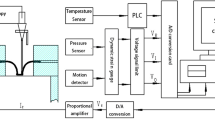Abstract
Embossment formation in press forging of AZ31 magnesium-alloy thin-walled structural components used in the electronics industry was examined by both the finite element analysis and the experimental approach in the present study. The mechanical properties of the AZ31 magnesium-alloy at elevated temperatures were first obtained from the compression tests under various strain-rates. The compression test results suggest that a feasible press forging process of AZ31 magnesium-alloy needs to be conducted at a forming temperature higher than 300°C. The ring compression tests were also performed at various temperatures to obtain the friction factors at the die-blank interface under different lubrication conditions. The experimental results were then employed in the finite element simulations to investigate the effects of process parameters, such as punch shape and sheet thickness on the formation of embossments in a press forging process, and a modified punch shape was proposed to improve the efficiency of embossment formation according to the finite element analysis. Experiments of press forging of AZ31 magnesium-alloy sheets were conducted to validate the finite element analysis. Good correlations were observed between the finite element simulation results and the experimental data in all respects. The experiments conducted in the present study not only validated the finite element analysis but also confirmed the efficiency of the modified die design in helping the embossment formation. The mechanical properties of AZ31 magnesium-alloy at elevated temperatures and the detailed examination of the material flow on the formation of embossments made in the present study could provide a design guideline for a press forging process of AZ31 magnesium-alloy sheets.
Similar content being viewed by others
References
Doege E, Droder K (2001) Sheet metal forming of magnesium wrought alloys-formability and process technology. J Mater Proc Tech 115:14–19
Koga N, Paisarn R (2001) Oil-free deep drawing of AZ31 magnesium alloy sheets using hard thin-film-coated tools. J JSTP 42(481):145–149
Yong MS, Hu BH, Choy CM, Kreij AV (2003) Evaluation on the formability of magnesium alloy, AZ31. Mater Sci Forum 437–438:435–438
Noster U, Scholtes B (2001) Stress-controlled fatigue of magnesium wrought alloy AZ31 in the temperature range 20–300°C. Z Metallkd 92(3):260–264
Emley EF (1996) Principles of magnesium technology. Pergamon, Oxford
Watanabe H, Tsutsui H, Mukai T, Kohzu M, Tnabe S, Higashi K (2001) Deformation mechanism in a coarse-grained Mg-Al-Zn alloy at elevated temperatures. Int J Plast 17:387–397
Takuda H, Fujimoto H, Hatta N (1998) Modeling on flow stress of Mg-Al-Zn alloys at elevated temperatures. J Mater Proc Tech 80–81:513–516
Yong MS, Lim SCV (2003) Investigating the plastic deformation behaviour of magnesium alloy AZ31 by plane strain forging of U and H sections. 6th international conference on magnesium alloys and their applications, Wolfsburg, Germany, 18–20 November, pp 260–265
Kawalla R, Stolnikov A (2004) Deformation behaviour and microstructure development of magnesium AZ31 alloy during hot and semi-hot deformation. Adv Eng Mater 6(7):525–529
Ion SE, Humphreys FJ (1982) Dynamic recrystallisation and the development of microstructure during the high temperature deformation of magnesium. Acta Metallurgica 30:1909–1919
Kobayashi S, Oh S-I, Altan T (1989) Metal forming and the finite-element method. Oxford University Express, New York
Acknowledgements
The authors would like to thank the National Science Council of the Republic of China for financially supporting this research under the Contract No. NSC-89-2212-E-002-147, which makes the experimental work possible. They also would like to thank the Chung-Shan Institute of Science and Technology for providing the AZ31 magnesium-alloys for experiment. The help from the Scientific Forming Technologies Corporation in running the DEFORM-3D program is highly appreciated as well.
Author information
Authors and Affiliations
Corresponding author
Rights and permissions
About this article
Cite this article
Chen, FK., Huang, TB. & Chen, SG. Embossment formation in press forging of AZ31 magnesium-alloy sheets. Int J Adv Manuf Technol 32, 272–279 (2007). https://doi.org/10.1007/s00170-005-0330-4
Received:
Accepted:
Published:
Issue Date:
DOI: https://doi.org/10.1007/s00170-005-0330-4




